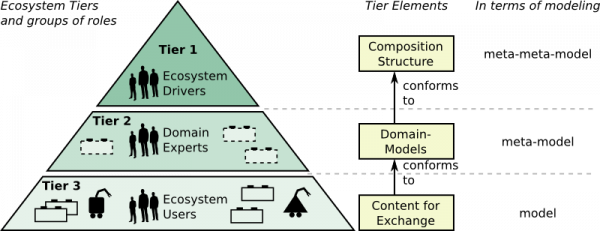User Tools
Table of Contents
Ecosystem Organization
Composition Tiers
The general composition structure distinguishes three tiers.
RobMoSys envisions a robotics business ecosystem in which a large number of loosely interconnected participants depend on each other for their mutual effectiveness and individual success. The modeling foundation guidelines and the meta-meta-model structures are driven by the needs of the typical tiers of an ecosystem and the needs of their stakeholders (see figure 1). The different tiers are arranged along levels of abstractions. Figure 1 also illustrates the amount of experts or people contributing or using the particular tiers.
Tier 1 structures the ecosystem in general for robotics. It is shaped by the drivers of the ecosystem that define an overall composition structure which enables composition and which the lower tiers conform to (similar to, for example, the ecosystem of the Debian GNU/Linux OS and its structures). Tier 1 is shaped by few representative experts for ecosystems and composition. This is kick-started by the RobMoSys project. Structures defined on Tier 1 can be compared to structures that are defined for the PC industry. The personal computer market is based on stable interfaces that change only slowly but allow for parts changing rapidly since the way parts interact can last longer than the parts themselves and there is a huge amount of cooperating and competing players involved. This resulted in a tremendous offer of composable systems and components.
Tier 2 conforms to these foundations, structuring the particular domains within robotics and is shaped by the experts of these domains, for example, object recognition, manipulation, or SLAM. Tier 2 is shaped by representatives of the individual sub-domains in robotics.
Tier 3 conforms to the domain-structures of Tier 2 to supply and to use content. Here are the main “users” of the ecosystem, for example component suppliers and system builders. The number of users and contributors is significantly larger than on the above tiers as everyone contributing or using a building block is located at this tier.
Tier 1: Composition-Structure – Meta-Structure
Tier 1 structures the ecosystem in general for robotics, independent of the sub-domains. It is shaped by the drivers of the ecosystem that define an overall structure which enables composition and which is to be filled by the lower tiers. Tier 1 defines general concepts and models for system composition such as the concept of service definitions, concept of components, and the composition-workflow that is tailored to service robotics. See Tier 1 Details for more information.
In terms of meta-modeling, elements of this tier correspond to/are meta-meta-models
Elements on this tier
RobMoSys Composition Structures, e.g.
- concept of service definitions
- concept of components, i.e. the Component Metamodel
- a set of communication semantics to choose from
Examples of roles on this tier
Content on this tier is defined by the ecosystem drivers, i.e. the RobMoSys community with moderation of the RobMoSys consortium.
See also
Tier 2: Robotics-Domain-Specific Structures – Robotics Domain Models
Tier 2 structures the particular domains within service robotics. It is shaped by the experts of these domains, for example experts from object recognition, from manipulation, or from SLAM. This is a community effort which structures each robotics domain by creating domain-models. Experts working at this level define concrete service definition models, for example a service definition for robot localization.
Domain-models, for example, are “Service Definitions” that cover data structure, communication semantics and additional properties for specific services such as “robot localization”. To find such a service definition, domain experts of each particular domain discuss how to represent the location/position of a robot and what additional attributes are required and how they are represented (e.g. how the accuracy is represented).
In terms of meta-modeling, elements of this tier correspond to/are meta-models
Examples of elements on this tier
- service definitions for localization
- definition of how a robot pose with uncertainty is represented
Examples of roles on this tier
- These are experts in the particular domain (SLAM, object recognition, manipulation), for example the manipulation domain to come up with domain-models for a composable motion stack based on the RobMoSys composition structures on Tier 1.
- Service Designer role
Tier 3: Ecosystem Content
Tier 3 uses the domain-structures from Tier 2 to fill them with content: to supply or to use content. It is shaped by the users of the ecosystem, for example component suppliers and system builders. They use the domain-models to create models as actual “content” of the ecosystem to be supplied and used. On this tier, for example, concrete Gmapping component for SLAM that provides a localization service is supplied to a system builder to compose a delivery robot.
In terms of meta-modeling, elements of this tier correspond to/are models (of components/systems)
Examples of elements on this tier
- Components for AMCL localization, Gmapping, etc. providing a localization service
- Task plot: how to make coffee
- Composed applications: A restaurant butler robot
- Component model based on the Component Metamodel
Examples of roles on this tier
RobMoSys Modeling Support
- See the various meta-models of the RobMoSys composition structures.
RobMoSys Tooling Support
- See how the SmartMDSD Toolchain supports the RobMoSys Ecosystem Organization in three composition tiers
See also
Acknowledgement
http://www.robmosys.eu/wiki/general_principles:ecosystem:start


